
Grappling is a fighting technique based on throws, trips, sweeps, clinch fighting, ground fighting and submission holds.
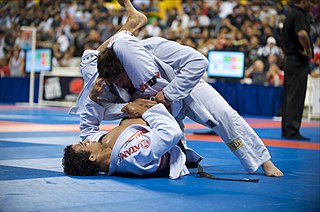
Brazilian jiu-jitsu is a self-defence martial art and combat sport based on grappling, ground fighting, and submission holds. BJJ focuses on taking ones opponent down to the ground, gaining a dominant position, and using a number of techniques to force them into submission via joint locks, chokeholds or compression locks.
Professional wrestling holds include a number of set moves and pins used by performers to immobilize their opponents or lead to a submission. This article covers the various pins, stretches and transition holds used in the ring. Some wrestlers use these holds as their finishing maneuvers, often nicknaming them to reflect their character or persona. Moves are listed under general categories whenever possible.
A suplex is an offensive move used in sport wrestling as well as amateur wrestling and professional wrestling. It is a throw that involves lifting the opponents and bridging or rolling to slam them on their backs.
Strikes can be offensive moves in professional wrestling, that can sometimes be used to set up an opponent for a hold or for a throw. There are a wide variety of strikes in pro wrestling, and many are known by several different names. Professional wrestlers frequently give their finishers new names. Occasionally, these names become popular and are used regardless of the wrestler performing the technique.
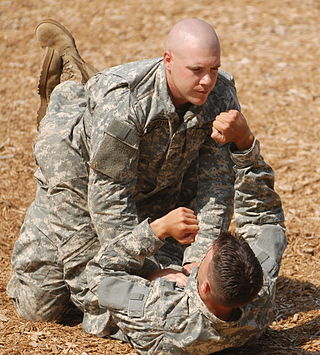
The guard is a ground grappling position in which one combatant has their back to the ground while attempting to control the other combatant using their legs. In pure grappling combat sports, the guard is considered an advantageous position, because the bottom combatant can attack with various joint locks and chokeholds, while the top combatant's priority is the transition into a more dominant position, a process known as passing the guard. In the sport of mixed martial arts, as well as hand-to-hand combat in general, it is possible to effectively strike from the top in the guard, even though the bottom combatant exerts some control. There are various types of guard, with their own advantages and disadvantages.
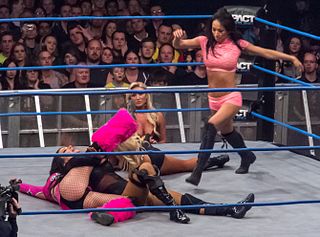
In professional wrestling, a pin is a move where a wrestler holds an opponent's shoulders to the mat in an attempt to score a fall. A pinfall is a common victory condition, where the attacker pins an opponent and the referee makes a three count before the opponent gets released from the pin.
In professional wrestling double-team maneuvers are executed by multiple wrestlers instead of one and typically are used by tag teams in tag team matches. Many of these maneuvers are combination of two throws, or submission holds. Most moves are known by the names that professional wrestlers give their "finishing move" names. Occasionally, these names become popular and are used regardless of the wrestler performing the technique. Moves are listed under general categories whenever possible.

A chokehold, choke, stranglehold or, in Judo, shime-waza is a general term for a grappling hold that critically reduces or prevents either air (choking) or blood (strangling) from passing through the neck of an opponent. The restriction may be of one or both and depends on the hold used and the reaction of the victim. While the time it takes for the choke to render an opponent unconscious varies depending on the type of choke, the average across all has been recorded as 9 seconds.
An armlock in grappling is a single or double joint lock that hyperextends, hyperflexes or hyperrotates the elbow joint or shoulder joint. An armlock that hyper-extends the elbow is known as an armbar, and it includes the traditional armbar, the shoulder triangle armbar, and the shotgun armbar. An armlock that hyper-rotates the arm is known as an armcoil, and includes the americana, kimura, and omaplata. Depending on the joint flexibility of a person, armcoils can either hyper-rotate only the shoulder joint, only the elbow joint, or both the elbow joint and shoulder joint.

Back mount, or rear mount, is a dominant grappling position where the practitioner is on their opponent's back in such a way that they have control of their opponent. Ideally, the opponent will be recumbent (prone), while the practitioner centers their weight atop the opponent, either in a seated or recumbent posture. Many consider back mount to be a very dominant, perhaps even the most advantageous position in grappling. This is due to the practitioner being able to attack with strikes and submissions with the opponent having a severely limited ability to see incoming attacks and defend against them.

Clinch fighting or trapping is the part of stand-up fighting where the combatants are grappling in a clinch, typically using clinch holds. Clinching the opponent can be used to eliminate the opponent's effective usage of some kicks, punches, and melee weapons. The clinch can also be used as a medium to switch from stand-up fighting to ground fighting by using takedowns, throws or sweeps.

A nelson hold is a grappling hold which is executed by one person from behind the opponent, generally when both are on the mat face down with the opponent under the aggressor. One or both arms are used to encircle the opponent's arm under the armpit, and secured at the opponent's neck. Several different nelson holds exist, and they can be separated according to the positioning of the encircling arm(s). A nelson is used to control an opponent or to turn them over onto their back and execute a pin.

A grappling hold, commonly referred to simply as a hold that in Japanese is referred to as katame-waza, is any specific grappling, wrestling, judo, or other martial art grip that is applied to an opponent. Grappling holds are used principally to control the opponent and to advance in points or positioning. The holds may be categorized by their function, such as clinching, pinning, or submission, while others can be classified by their anatomical effect: chokehold, headlock, joint-lock, or compression lock. Multiple categories may be appropriate for some of these holds.
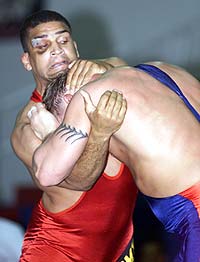
An underhook is a clinch hold that is used in grappling to control the opponent. It is performed from any direction by putting an arm under the opponent's arm, and holding the opponent's midsection or upper body. Having an underhook with one arm is called a single underhook, while having underhooks with both arms is known as double underhooks. The typical response to an underhook is to try to break it, or to establish an overhook.

In wrestling, an overhook is a clinch hold that is used to control the opponent. It is sometimes incorrectly called a wizard, which is a malapropism of whizzer. An overhook is performed from any direction by putting an arm over the opponent's arm, and encircling the opponent's arm or upper body. Having an overhook with one arm is called a single overhook, while having overhooks with both arms is known as double overhooks. Overhooks are typically employed in response to underhooks by an opponent.

A pinch grip tie, or an over-under bodylock, is a clinch hold and stand-up grappling position that is an extension of the over-under position, but having both hands locked behind the opponents back. The hands are typically locked with a palm-to-palm grip, palm-to-wrist grip or fingers-to-fingers grip. The pinch grip tie can be used to throw the opponent, but usually the grapplers attempt to obtain a better hold such as double underhooks or double collar tie. The pinch grip tie is often a neutral position when both grapplers symmetrically have the same hold on each other.
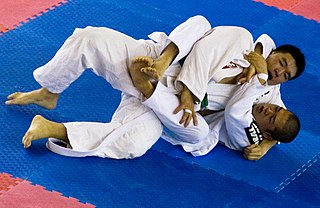
In combat sports, a spinal lock is a multiple joint lock applied to the spinal column, which is performed by forcing the spine beyond its normal ranges of motion. This is typically done by bending or twisting the head or upper body into abnormal positions. Commonly, spinal locks might strain the spinal musculature or result in a mild spinal sprain, while a forcefully and/or suddenly applied spinal lock may cause severe ligament damage or damage to the vertebrae, and possibly result in serious spinal cord injury, stroke, or death. Spinal locks and cervical locks are forbidden in all gi competitions, IBJJF Brazilian jiu-jitsu competitions, amateur mixed martial arts (MMA), multiple forms of no Gi jiu-jitsu, judo, and other martial arts. However, professional MMA and some no gi Brazilian jiu-jitsu competitions do permit spinal locks and, particularly, neck cranks, and such moves are trained in various MMA and Brazilian jiu-jitsu schools.
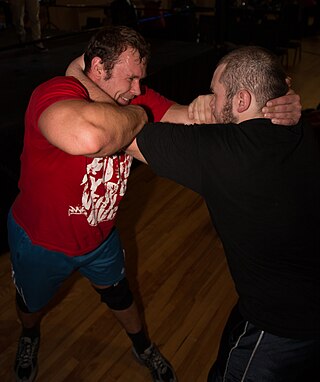
A collar-and-elbow hold is a stand-up grappling position where both combatants have a collar tie, and hold the opponent's other arm at the elbow. Generally the opening move in professional wrestling, the collar-and-elbow is generally a neutral position, but by pushing the hand on the elbow to the inside of the opponent's arms, and holding the biceps, more control can be obtained. From here it will be easier to strike or to attempt takedowns, while defending against the opponent's techniques.

Over–under is a stand-up grappling position in which both combatants have one overhook and one underhook, and is the most common stand-up grappling position in mixed martial arts. The head is typically on the same side as the overhooked arm, to allow greater weight to be put on the opponent's underhooked arm, and hence preventing the opponent from using the underhooked arm effectively. The over–under position can be advanced into a pinch grip tie by locking the hands behind the opponent's back.















